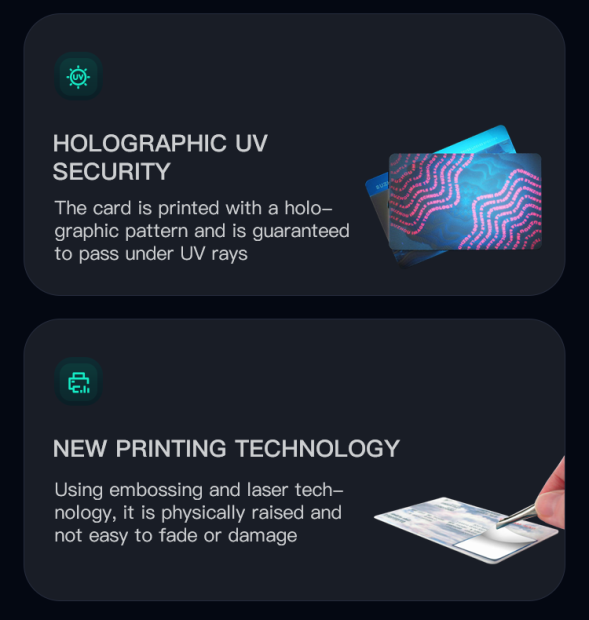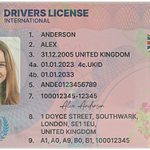Understanding Real ID
The Real ID Act was enacted in response to security concerns following the September 11, 2001, terrorist attacks in the United States. It sets minimum security standards for state – issued driver’s licenses and identification cards. A Real ID is not just an ordinary form of identification; it serves as a more secure way to verify a person’s identity for certain federal purposes. For example, it is required for accessing federal facilities, boarding commercial flights within the United States starting from a specific compliance deadline, and other sensitive activities.
Real ID – compliant cards are distinguishable by a special symbol, usually a star in the upper – right corner of the card. States are responsible for implementing the Real ID requirements, and they have established their own procedures for issuing these enhanced identification documents.
Political Asylum Status and Its Implications
Political asylum is a legal protection granted to individuals who have fled their home countries due to a well – founded fear of persecution based on race, religion, nationality, political opinion, or membership in a particular social group. When a person is granted political asylum in the United States, they are provided with certain rights and protections, but they also need to navigate various aspects of life in the new country, including obtaining necessary identification.

Having a political asylum status means that an individual is in a unique legal situation compared to U.S. citizens or permanent residents. While they are on a path to potentially gain more stable immigration status in the future, in the short – term, they must follow specific procedures when it comes to obtaining documents like a Real ID.
The General Process of Applying for a Real ID
-
Determine Eligibility: First, applicants must determine if they are eligible for a Real ID. This includes meeting the state’s residency requirements, providing proof of identity, Social Security number (if applicable), and proof of residency.
-
Gather Required Documents: The list of required documents typically includes a valid passport or other primary identity documents, such as a birth certificate. For proof of Social Security number, an original Social Security card is often required. To prove residency, documents like utility bills, lease agreements, or bank statements can be used.
-
Visit a Motor Vehicle Department (MVD) Office: Applicants need to make an appointment (in some states) or walk – in to the local MVD office. They will be required to present their documents for verification. The MVD staff will review the documents to ensure they meet the Real ID requirements.
-
Provide Biometric Information: This usually includes having a photograph taken and providing fingerprints (in some cases). The biometric information is used to further verify the applicant’s identity.
-
Pay the Application Fee: There is a fee associated with applying for a Real ID, which varies by state. Once the application is approved and the fee is paid, the applicant will receive their Real ID within a specified time frame, which can range from a few days to several weeks depending on the state’s processing times.
Applying for a Real ID with a Political Asylum Status
For individuals with a political asylum status, the basic steps of the Real ID application process are similar to those for other applicants, but there are some additional considerations and specific documents that may be required.
Proof of Identity: In addition to the standard identity documents like a foreign passport (if available), individuals with asylum status may need to provide their asylum – related documents. This can include the asylum approval notice or other official documents issued by the U.S. Citizenship and Immigration Services (USCIS) that verify their asylum status. These documents serve as an important part of establishing their identity and legal status in the United States.
Proof of Residency: Just like other applicants, those with asylum status must prove their current residency in the state where they are applying for the Real ID. This can be done through the same types of documents such as utility bills, lease agreements, or bank statements. However, if they have recently changed their address due to their asylum – related circumstances (such as being relocated to a different area for safety reasons), they may need to provide additional documentation to explain the change.
Social Security Number: If the individual has been assigned a Social Security number as part of their asylum – related processing, they must provide the original Social Security card. In some cases, if they have not yet received a Social Security number, they may need to provide documentation showing that they have applied for one or that they are not eligible for one (for example, if they are not eligible to work in the U.S. immediately after being granted asylum).
When visiting the MVD office, it is important for asylum – status applicants to clearly communicate their asylum status to the staff. This can help avoid any misunderstandings or delays in the application process. The MVD staff may be trained to handle such cases, but it is still beneficial for the applicant to be prepared to answer any questions related to their asylum – related documents and circumstances.
Common Problems and Solutions
Problem 1: Incomplete or Inaccurate Documentation
Description: Applicants with asylum status may have difficulty gathering all the required documents or may have documents with inaccuracies, such as misspelled names or incorrect dates. This can lead to the rejection of their Real ID application.
Solution: Start the document – gathering process well in advance. Check each document carefully for accuracy. If there are any errors, contact the relevant issuing agencies to correct them. For example, if the name on the asylum approval notice is misspelled, reach out to the USCIS to request a corrected version. Make copies of all original documents for your records and bring the originals to the MVD office.
Problem 2: Language Barriers
Description: Many individuals with political asylum status may not be fluent in English. This can make it difficult for them to understand the application instructions, communicate with the MVD staff, and complete the application forms accurately.
Solution: Some states offer translation services at the MVD offices. Check with the local MVD to see if this is available. If not, consider bringing a trusted translator who is fluent in both English and the applicant’s native language. Additionally, some states may have application forms available in multiple languages. Download the forms in the applicant’s native language if possible and fill them out carefully before going to the MVD office.
Problem 3: Delays in Receiving Asylum – Related Documents
Description: Sometimes, there can be delays in receiving asylum – related documents from the USCIS, such as the asylum approval notice. This can hold up the Real ID application process as these documents are often required as proof of identity and legal status.
Solution: Follow up with the USCIS regularly to inquire about the status of your documents. You can use the USCIS online case – tracking system or contact their customer service. If there are significant delays, consider providing an explanation to the MVD along with any evidence of your follow – up efforts with the USCIS. In some cases, the MVD may be able to accept alternative forms of documentation while waiting for the official asylum – related documents to arrive.
Problem 4: Difficulty Proving Residency
Description: Asylum – seekers may have had unstable living situations, such as staying in shelters or with temporary hosts. This can make it challenging to provide the traditional forms of residency proof like utility bills or lease agreements.
Solution: If staying in a shelter, ask the shelter management for a letter stating your stay there, including the start and end dates (if applicable). If living with a host, the host can provide a notarized letter along with a copy of their own identification and proof of their residency. Additionally, some states may accept other forms of documentation, such as a letter from a social service agency that has been assisting the asylum – seeker, as proof of residency.
Problem 5: Fear of Disclosing Asylum Status
Description: Some individuals with asylum status may be hesitant to disclose their status due to fear of negative consequences, such as potential retaliation from their home country or other security concerns.
Solution: It is important to understand that the MVD staff is bound by confidentiality laws. Reassure the applicant that their information will be kept private. Additionally, remind them that providing accurate information is necessary for a successful Real ID application. If they are still overly concerned, they can consult with an immigration attorney or a legal aid organization for further guidance on how to navigate the application process while protecting their privacy and security as much as possible.
Fake ID Pricing
unit price: $109
| Order Quantity | Price Per Card |
|---|---|
| 2-3 | $89 |
| 4-9 | $69 |
| 10+ | $66 |


